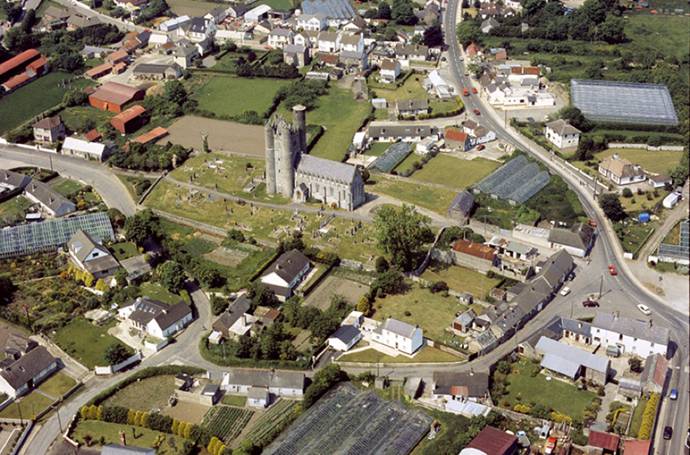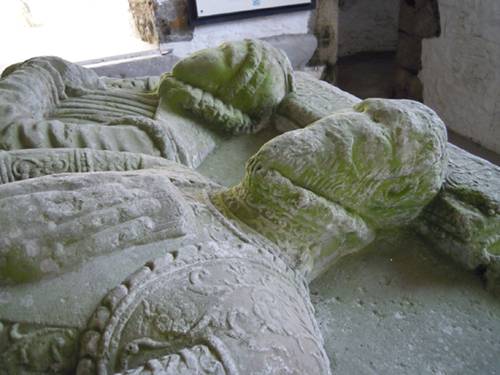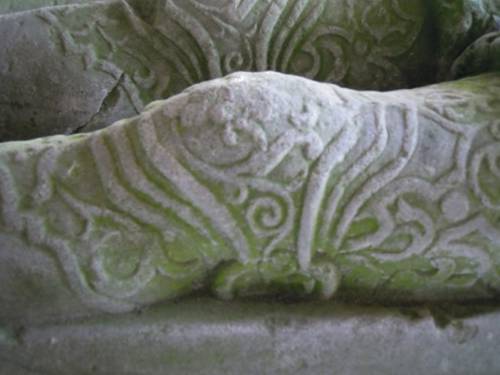Barnewall Effigial Tomb, Lusk, Co. Dublin

Secular patronage of the arts during the late 16th century is exquisitely demonstrated in this Renaissance effigial tomb at Lusk, County Dublin. Currently housed in the medieval belfry tower at Lusk this chest tomb was commissioned in 1589 by Sir Lucas Dillon of Moymet (d. 1595), the 2nd husband of Marion Sharl (d.1607), to house the remains of her first husband Sir Christopher Barnewall of Turvey (d. 1575) On the death of her parents Marion Sharl had been made a ward of Patrick Barnewall, Christopher’s father. She later married Christopher and according to the inscription at the east end of the chest Marion “had issu 5 sonnes and 15 dacters by hem.” She married Sir Lucas Dillon, three years after her first husband’s death.
The chest tomb and effigies in high relief are carved from limestone, possibly sourced from a local quarry. The west and east ends of the chest are devoted to a single composition. The west end bears the arms of Barnewall quarted with those of Sharl, the shield being surmounted by the Barnewall crest. The names Christopher Barnewall and Marion Sharl appear on either side of the heraldic plumes.


The north and south sides are divided into three sections by fluted ionic pilasters supporting an arcade of paired rounded arches with a central segmental arch. Within each panel a single armorial shield forms the prominent feature with the central shield dominating in scale and subsidiary shields set in smaller double-arched frames. Small grotesque masks act as corbels supporting the central arch of the end panels. The dedication inscription is carried on the east end of the tomb within an elaborate cartouche more reminiscent of Mannerism than of the sedate Renaissance idiom of the rest of the tomb. It declares:
“THIS MONIMENT IS MADE FOR THE RIGHT WORSHIPFULL SR CHRISTOPHER BERNEWALL OF TURVEY KNIGHT BY THE RIGHT WORSHIPFULL SR LUKCAS DILLON OF MOYMETT KNIGHT AND DAEM MARION SHRARL WHO MARIED HEERR 3 YEAR AFTER THE DEATH OF THE SAID SER CHRISTOPHER HER FIRST AND LOVING HOOSBAND WHO HAD ISSU 5 SONNES AND 15 DACTERS BY HEM.”
A list of names of the children of Sir Christopher and Marion is carried on a band above the base moulding - possibly added after the tomb was assembled.
Above, slightly over life size, the effigies are recumbent, with Marion’s hands folded in prayer, Sir Christopher’s securing an open book against his breastplate.

Their heads lie on an embroidered and tasselled cushion which bears the following inscription in raised letters:
“Soli Laudes Deo Si Deus Nobiscum Quis Contra Nos – Praise the Lord alone, if the Lord is with us who can be against us”.
Their footrests were faithful dogs whose extremities, heads and tails, are now missing.

Sir Christopher is clad as a knight in highly ornamented armour showing the influence of fashions derived from Milanese and later German armourers (Jocelyn 1973 156). Bare-headed, his hair and beard are carefully modelled while the detail of his face is abraded. A ruff peeks out the top of his neck and at the wrists. The all over raised ornamentation of curvilinear foliate motifs, four-petal rosettes, and tapering bands and braids is designed to emphasise the distinctive forms of body armour.

The gorget (leather or metal collar), paulrone (shoulder plate armor), the breastplate, the tassets (horizontal bands of plate forming a short petticoat), couter (plate protecting the elbow) poleyn (plate protecting the knee), cuisse (plate protecting the upper leg) greaves (plate protecting the lower leg) can all be distinguished. Two opposed motifs are alternatively repeated down the tassets.

His sword, attached to the belt rests along his left side, the normal location of weaponry. While the decorated surfaces are busy and the detail sharp and well executed, the overall impression is one of a balanced and harmonious design.
Marion is dressed in a loose fitting, long sleeved gown with a broad ruffle at the neck and embroidered collar covering the shoulders with paired braids running under the arms. The sleeves of this garment are very naturalistically modelled. The outer edge of her gown is folded back to reveal a gorgeously embroidered lining decorated with rosettes and scrolls with matching ornamented kirtle. Upon the kirtle is a square pomander which is suspended from the waist on a belt and leather/metal chain. Her head is covered by a French hood, a tight-fitting cap with a jewelled billement ornament and unfortunately the facial details are abraded.

The Barnewall tomb is very important stylistically as it heralds the Renaissance in tomb decoration in Ireland – the plaster work in Carrick-on-Suir Ormond Castle dating to 1565 being an architectural precursor. While the overall form is late-Gothic the decoration is Late Renaissance and in relation to the east end cartouche almost Mannerist. It is considered that the masons responsible for the Lusk tomb were trained in and were certainly conversant with the work of some provincial midland or southern English Schools themselves deriving inspiration from Flemish work or Flemish pattern books. Such is the accuracy of the depiction of the armour that it has been suggested that the original model was North Italian dating to the 1560’s. Wholly secular in its iconography there is a marked omission of religious symbols, the patron Sir Lucas Dillon “notorious recusancy and wilful absenting himself from the Church these three or four years past” (Calender of State Papers relating to Ireland, 22nd September 1590). This fabulous monument is accessible to all, with the key being held by Mrs Kelly, who resides in a bungalow just beside the old Kelly garage on the Dublin side of Lusk.

Calendar of State Papers relating to Ireland, 1588-1592, p. 366, 22 September 1590.
Jocelyn, J. 1973 The Renaissance tombs of Lusk and Newton Trim. Journal of the Royal Society of Antiquaries of Ireland 103, 153-56.
